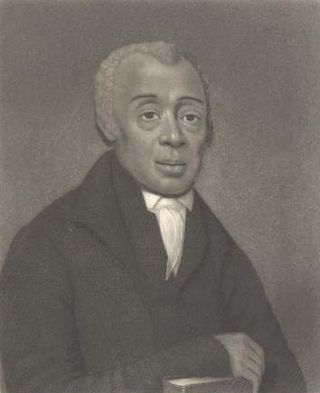
Richard Allen was a minister, educator, writer, and one of the United States' most active and influential Black leaders. In 1794, he founded the African Methodist Episcopal Church (AME), the first independent Black denomination in the United States. He opened his first AME church in 1794 in Philadelphia.
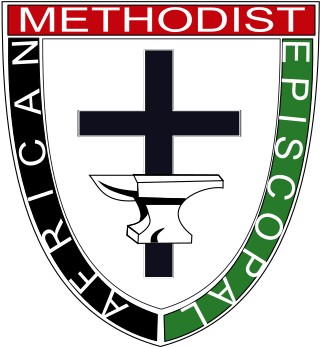
The African Methodist Episcopal Church, usually called the AME Church or AME, is a predominantly African American Methodist denomination. It adheres to Wesleyan-Arminian theology and has a connexional polity. The African Methodist Episcopal Church is the first independent Protestant denomination to be founded by black people; though it welcomes and has members of all ethnicities.
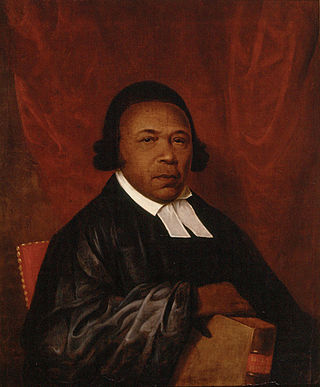
Absalom Jones was an African-American abolitionist and clergyman who became prominent in Philadelphia, Pennsylvania. Disappointed at the racial discrimination he experienced in a local Methodist church, he founded the Free African Society with Richard Allen in 1787, a mutual aid society for African Americans in the city. The Free African Society included many people newly freed from slavery after the American Revolutionary War.

The Mother Bethel African Methodist Episcopal Church is an historic church and congregation which is located at 419 South 6th Street in Center City Philadelphia, Pennsylvania, USA. The congregation, founded in 1794, is the oldest African Methodist Episcopal congregation in the nation.

The African Methodist Episcopal Zion Church, or the AME Zion Church (AMEZ) is a historically African-American Christian denomination based in the United States. It was officially formed in 1821 in New York City, but operated for a number of years before then. The African Methodist Episcopal Zion Church adheres to Wesleyan-Arminian theology.
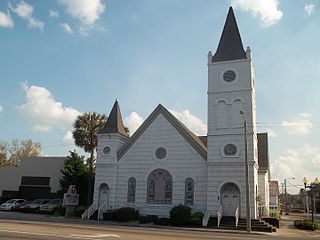
The black church is the faith and body of Christian congregations and denominations in the United States that minister predominantly to African Americans, as well as their collective traditions and members. The term "black church" can also refer to individual congregations.

William White was the first and fourth Presiding Bishop of the Episcopal Church of the United States, the first bishop of the Diocese of Pennsylvania (1787–1836), and the second United States Senate Chaplain. He also served as the first and fourth President of the House of Deputies for the General Convention of the Episcopal Church.

The Episcopal Diocese of Pennsylvania is a diocese of the Episcopal Church in the United States of America encompassing the counties of Philadelphia, Montgomery, Bucks, Chester and Delaware in the state of Pennsylvania.

St. Peter's Church is a historic Episcopal church located on the corner of Third and Pine Streets in Philadelphia, Pennsylvania. It opened for worship on September 4, 1761 and served as a place of worship for many of the United States Founding Fathers during the period of the Continental Congresses. The building was designated a National Historic Landmark in 1996. The church remains an active parish; the current rector is the Rev. Claire Nevin-Field.

St. George's United Methodist Church, located at the corner of 4th and New Streets, in the Old City neighborhood of Philadelphia, is the oldest Methodist church in continuous use in the United States, beginning in 1769. The congregation was founded in 1767, meeting initially in a sail loft on Dock Street, and in 1769 it purchased the shell of a building which had been erected in 1763 by a German Reformed congregation. At this time, Methodists had not yet broken away from the Anglican Church and the Methodist Episcopal Church was not founded until 1784.

John Prentiss Kewley Henshaw was the fourth Bishop of Rhode Island in the Episcopal Church in the United States of America, and the first to hold that position alone.

Henry Ustick Onderdonk was the second Episcopal bishop of Pennsylvania.
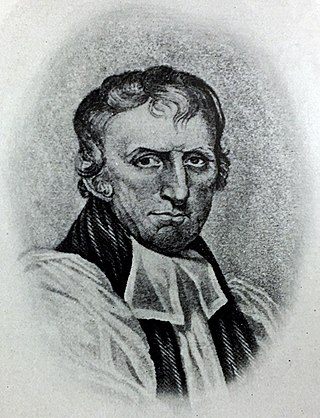
James Kemp was the second bishop of the Diocese of Maryland, US, from 1816 to 1827.

The Church of Saint Luke and The Epiphany is an Episcopal congregation located at 330 South 13th Street between Spruce and Pine Streets in the Center City neighborhood of Philadelphia, Pennsylvania. It is part of the Diocese of Pennsylvania. The church was formed in 1898 as a result of the merger of St. Luke's Church (1839) and The Church of The Epiphany (1834), which consolidated at St. Luke's location.

William Douglass (1804–1862) was an abolitionist and Episcopal priest. He preached for peace, racial equality, and education in the religious community.
William Levington was an African-American clergyman and teacher. The third African American ordained as a priest in the Episcopal Church of the United States, he established the first African-American congregation south of the Mason–Dixon line, and worked to educate African American youth.
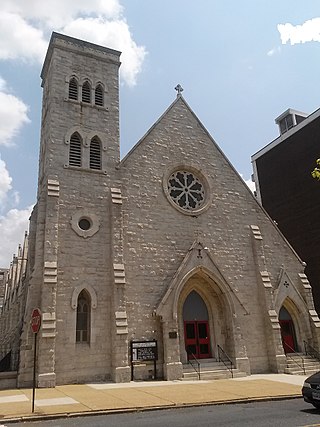
St. James Episcopal Church Lafayette Square, or St. James African Episcopal Church, founded in 1824, is a historic Episcopal church now located at 1024 W. Lafayette Avenue in the Lafayette Square Historic District of Baltimore, Maryland.
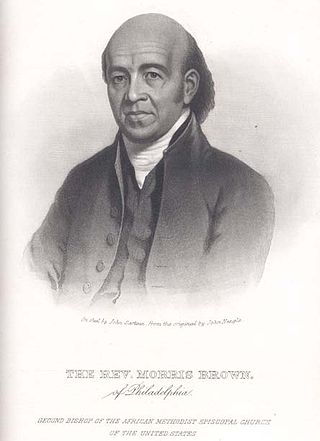
Morris Brown was one of the founders of the African Methodist Episcopal Church, and its second presiding bishop. He founded Emanuel AME Church in his native Charleston, South Carolina. It was implicated in the slave uprising planned by Denmark Vesey, also of this church, and after that was suppressed, Brown was imprisoned for nearly a year. He was never convicted of a crime.

Bishop Singleton T. Jones was a religious leader in the African Methodist Episcopal Zion Church. When he was ten years old, he was apprenticed to a lawyer and worked for him for four years, after which he found positions at an inn, as a hod carrier, and on a riverboat on the Ohio River. He became a pastor in the 1840s, serving churches throughout Pennsylvania, New Jersey, Maryland, and the District of Columbia. Although he had little education, he taught himself to be an articulate orator. Besides being a pastor to churches, he also edited AME Zion publications, the Zion's Standard and Weekly Review and the Discipline.

Henry Laird Phillips was an American social reformer and rector of the Church of the Crucifixion, an African American Episcopal Church congregation in Philadelphia. The Pennsylvania Historical and Museum Commission erected a commemorative marker outside the church in 1993. W. E. B. Du Bois praised Phillips as "one of the most valuable social reformers of the day."




















